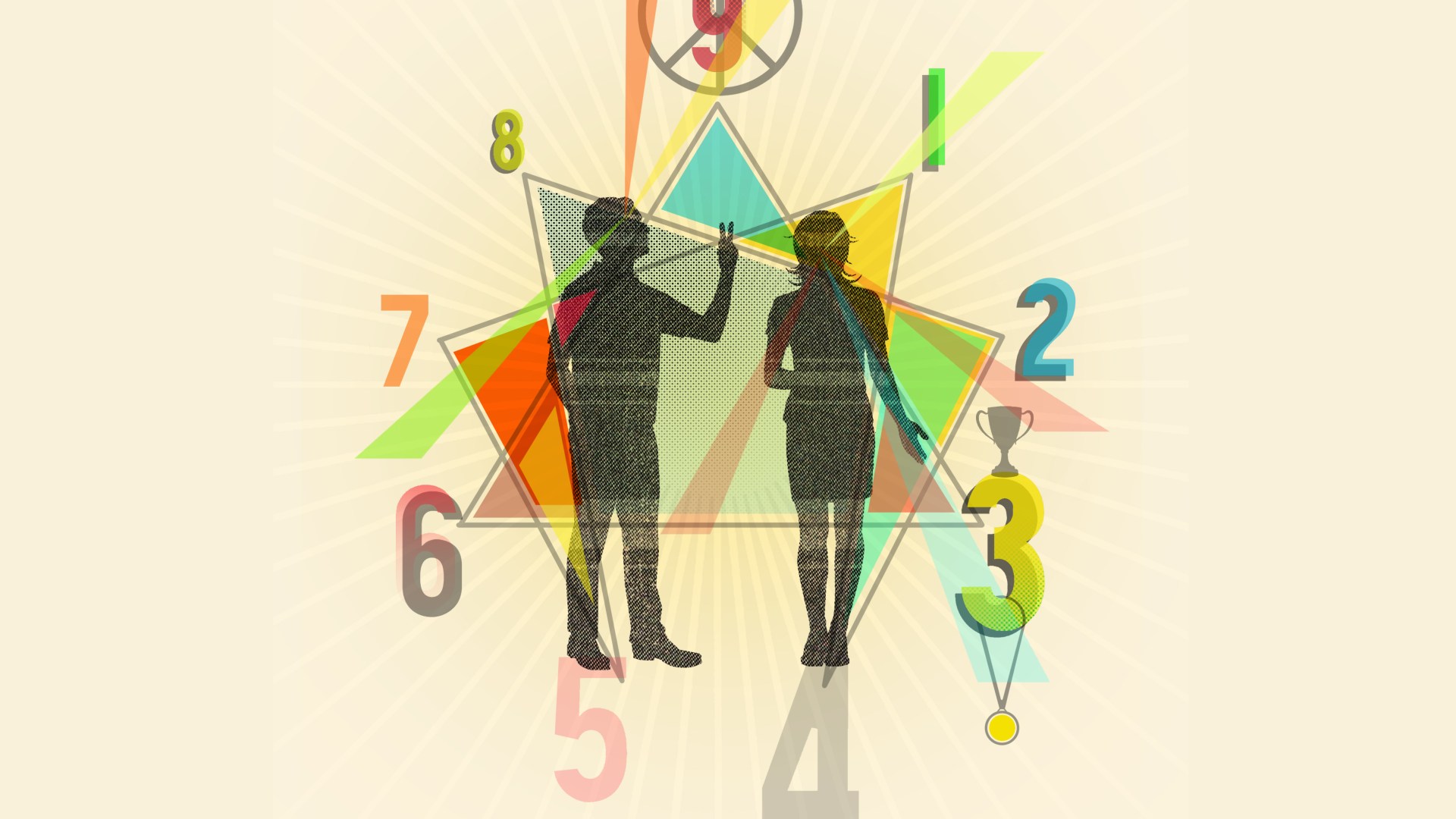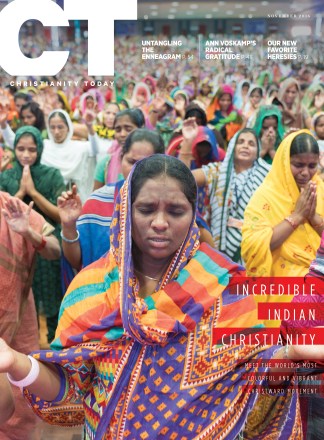Tools are fashioned in the image of their user. Hammers are productive in the hands of carpenters and malignant in the hands of an angry mob. Spiritual tools are a little more complicated than material tools, because souls are complicated. Prayer walking, guided meditation, and lectio divina can wield wonders in the hands of a mature Christian, counselor, or spiritual director. They can also wield destruction in the hands of someone who has only read a pamphlet or written a blog post.
Like every tool, a popular self-assessment test known as the Enneagram has the capacity to heal or to harm, depending on how it’s used. In the first Enneagram resource from an evangelical publisher, InterVarsity Press’s new release The Road Back to You: An Enneagram Journey to Self-Discovery, coauthor Ian Morgan Cron calls new Enneagram fans “number thumpers.” They “run around typing people and pets, hacking off family members, and alienating people who have no idea what they’re jabbering about,” he writes.
The Enneagram is not a spiritual tool, per se, but it is increasingly being used as one in church classes and faith-based counseling settings. Its origins are obscure. We do know that it was introduced in the West in the 1970s by Chilean psychiatrists, then adopted by Jesuit priests and popularized in 1992 by Franciscan spiritual director Richard Rohr’s Discovering the Enneagram: An Ancient Tool for a New Spiritual Journey.
My description thus far probably doesn’t give evangelicals warm feelings. Indeed, some connect the Enneagram’s roots to Sufism (Islamic mysticism), while others see in the Enneagram a Gnosticism that encourages users to find their “hidden,” true self.
As a pastor in a confessional and evangelical tradition, I want the people I counsel and lead to trust in the sufficiency of Scripture, the power of the gospel, the regular graces of gathered worship, the preaching of God’s Word, and the Lord’s Supper for spiritual growth. Leaders who share my convictions have been suspicious of using tools like the Enneagram. Even still, I believe the Enneagram can enhance, not replace, our participation in the normal means of Christian grace and growth.
What’s Your Number?
Most simply, the Enneagram is a system of categorizing people with a number—one through nine—that represents a core motivation or orientation to others and the world. Clearly these “types” do not explain or capture the whole of a person—and clearly we can imagine many more types of people than nine. Rather, the numbers are what Cron calls “imprecise maps” for how a person moves through the world. Most of the time, each person is a combination of at least two numbers.
Most personality tests such as the Myers–Briggs Type Indicator seek to identify personality “traits,” like introversion or intuition. The Enneagram goes deeper, looking at the motivations behind our traits. Traits are “partial giveaways” to what’s really going on, write Cron and Suzanne Stabile in the IVP book. The Enneagram aims to take users to the root.
The language of “blinders” is helpful here. Blinders assume blind spots. Put in the right hands, the Enneagram is a tool to show people how their inner life blinds them to certain patterns and motivations—even to certain virtues. But blinders also assume focus. At its best, the Enneagram aims to show why we impulsively go a particular direction in our imagination, why our hearts burn for one thing over another, or why we are exceptionally driven in certain areas and not in others.
Below is a description of each:
Diagnosis & Healing
At this point, we need to go beyond simply knowing our and others’ numbers and apply self-knowledge toward spiritual growth. It’s here where things can get tricky. Using information for transformation takes wisdom and care. Here are two principles for wise use of the Enneagram:
See self-knowledge as part of sanctification.
Part of maturing as a follower of Christ is maturing in our knowledge of self. This has been true since God warned Cain of the sin crouching at the doors of his heart (Gen. 4:7); since David asked God to search his heart and exposes any grievous ways (Ps. 139); since Augustine’s Confessions; since Calvin’s famous opening to his Institutes: “Our wisdom, in so far as it ought to be deemed true and solid Wisdom, consists almost entirely of two parts: the knowledge of God and of ourselves.”
If you know anything about your own self, it can often feel like a deep dark cavern where we have only the light of a matchstick to see and know our depths. We are a mystery to ourselves. The Enneagram is a tool that can turn the light of a matchstick into a torch. A torch light is still imprecise, but it provides a wider grasp of the terrain, can expose uncharted ground we need to explore, and keeps us from going down destructive paths.
The Enneagram helps shed light on the deep underlying emotions of fear, guilt, or shame. These emotions motivate us towards vice and self-destructive behavior. For example, Threes are often motivated by the shame of not being worthy of love, and use activity and accomplishment in order to “earn” love and acceptance. In moments when Threes find themselves rushing from one accomplishment to the next, they can practice simply being in God’s presence and receiving his unconditional love, through silent prayer or enjoying creation.
Use the Enneagram as a diagnosis, not a treatment.
Christians who are new to the Enneagram might start to see every new glimpse of self-knowledge as a sign of transformation. And there is healing that comes when we connect another dot of our story and see wounds that have never been addressed before. For some, linking past experiences to current shame, guilt, or fear can seem revolutionary. But like a diagnosis is only the first step of healing the body, a deeper self-awareness is only the first step for more effective soul care. The Enneagram is a tool to use to find sins to repent of, wounds to be healed, and fears to be comforted.
This is where Christian Enneagram users will look different from many mainstream users, who use the tool to find the “authentic you.” A strong cultural narrative says that healing means finding your authentic self and living out of that reality. But Christians believe we will be our “true selves” insofar as we are truly living out our new life in Christ.
Our union with Christ means we have access to infinite resources for healing and restoration. The Enneagram helps us see how fear might be controlling us, how shame might be motivating us, how guilt might be crippling us. Like a tracer chemical in the blood stream that helps identify the disease, the Enneagram brings to the surface indicators of what might be motivating sinful or harmful actions and patterns.
With those resources, we can press into Christ, seeking healing in the gospel. Living out of fear, guilt, or shame as a central motivator means that we are not fully experiencing our life in Christ and the power of the gospel. Therefore, we must go to the sympathetic High Priest (Heb. 4:15). Jesus Christ himself experienced the full range of human emotions: He knew the anxiety of judgment at the Cross. He knew the shame of being exposed and abandoned in death. He knew the guilt of becoming sin. Though he was without sin, he knew firsthand the consequences of sin, since he became sin for us (2 Cor. 5:21).
The Enneagram exposes to us where we need to come to Christ and seek transformation. In Christ, by the power of participation in his Spirit, we can experience healing of our fear, guilt, or shame. But also, in Christ is the power to imitate his virtues. So then, in Christ:
Ones can be freed from having to be morally perfect, learning to imitate Christ’s patience with the failures of others.
Twos learn that they are needy themselves and that in Christ they are loved and cherished by the Father, growing in service without expecting anything in return.
Threes learn they are not defined by their effectiveness and learn to find true rest.
Fours learn that though they feel misunderstood, they are known fully by God and can imitate Christ’s empathy towards others.
Fives can experience the generous friendship of God and can then follow Christ in being generous in their friendships and community.
Sixes learn that they are safe in Christ and so therefore can live with risk on earth.
Sevens learn that sadness can’t steal true, abiding joy but can actually deepen it.
Eights learn that they are not defined by their accomplishments and can follow Christ in laying down their power.
Nines find their peace ultimately in Christ, not in circumstances, and so can be true peacemakers among their friends.
The strength of the Enneagram is that it exposes where we might need healing and what vices might be causing division with others and even within ourselves. As Christians, we use the Enneagram as a tool to find healing not by becoming our true selves but by finding ourselves more truly in Christ. And we become more virtuous not by authenticity but by imitation.
John Starke is lead pastor of Apostles Uptown Church in New York City and co-editor of One God in Three Persons (Crossway).










